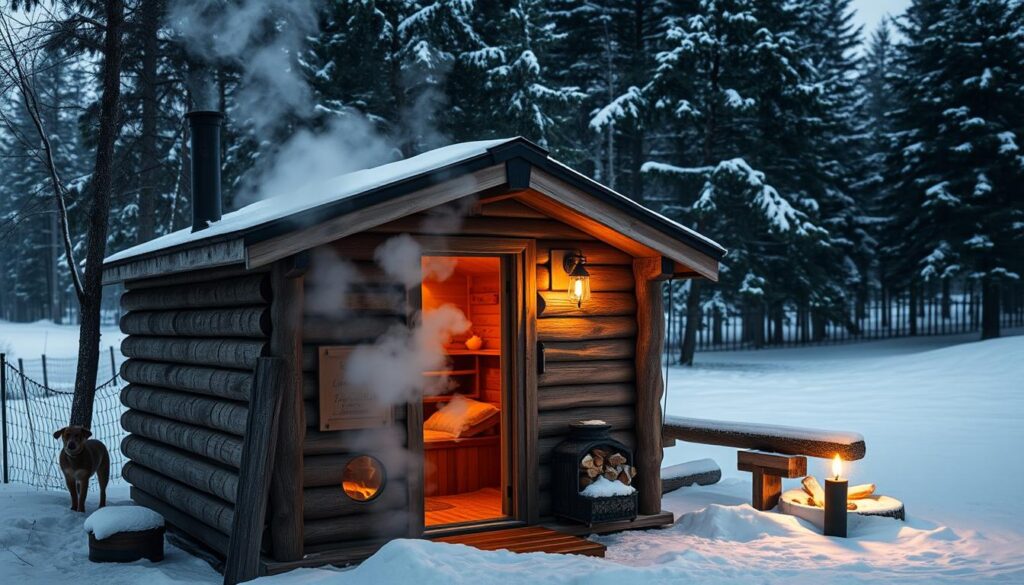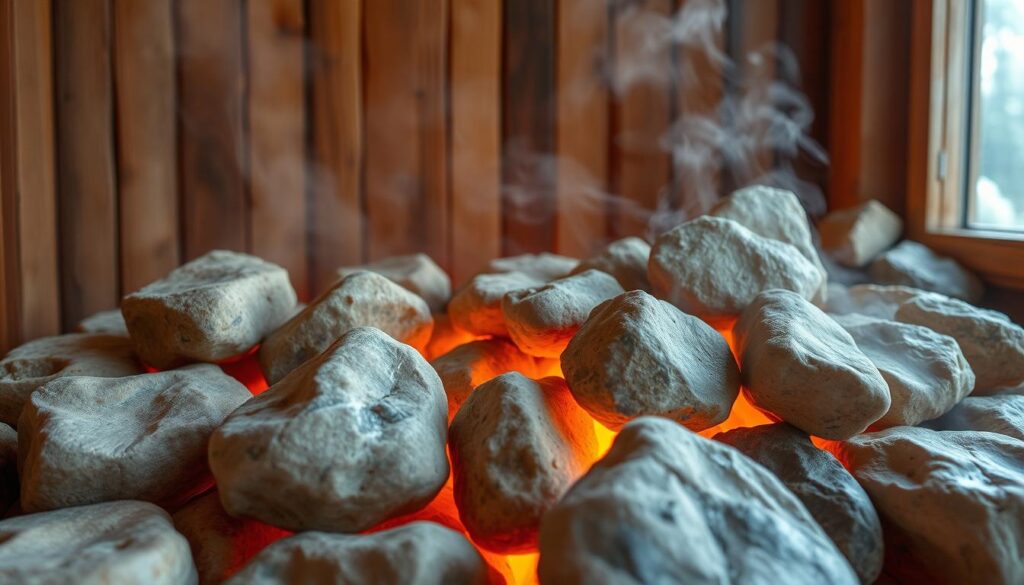Is your wood fired sauna losing its heat? Wondering how to keep your traditional Finnish sauna in top shape? Maintaining a wood fired sauna is easier than you think. Let’s explore the essential tips to keep your sauna experience alive.
Wood fired sauna are the true essence of traditional saunas. They offer a real and refreshing experience. Unlike electric saunas, these need a bit more care. But the effort is worth it for the amazing heat and cleansing sweat they provide.
Keeping your wood fired sauna in good shape is crucial. It’s about longevity, safety, and performance. Did you know it’s easier and cheaper to maintain than a hot tub or pool? With the right tips, you can enjoy your sauna for years without spending a lot or getting tired.
Choosing the right firewood and firing techniques are key to keeping your sauna perfect. Hardwoods like oak and maple heat better than softwoods. The goal is to heat quickly but not harm your stove or the environment.
Ready to become a sauna maintenance expert? Let’s dive into the essential tips for a wood fired sauna. Whether you’re a sauna pro or new to traditional saunas, these tips will enhance your Finnish-inspired oasis.
Table of Contents :
Key Takeaways
- Regular maintenance extends sauna lifespan and ensures safety
- Proper wood selection and firing techniques are crucial
- Cleaning routines preserve sauna hygiene and performance
- Balance between rapid heating and stove care is essential
- Wood fired sauna upkeep is less costly than hot tub maintenance
- Safety measures and inspections are vital for long-term use
Understanding the Importance of Wood Fired Sauna Maintenance
Wood fired sauna give a unique, traditional vibe. But to get the most out of them, regular maintenance is a must. Let’s dive into why keeping your sauna in great shape is important for its life and your safety.
Benefits of regular maintenance
Keeping your wood fired sauna in good shape is more than just cleaning. It’s about keeping the wood quality high, avoiding damage from temperature changes, and ensuring a clean space. By following a maintenance routine, you’re not just cleaning. You’re investing in your sauna’s long-term health.
Extending the lifespan of your sauna
Proper care can make your sauna last longer. Regular cleaning, wood treatment, and checking parts can add years to its life. For example, using the right cleaning products is essential. A mix of warm water and rubbing alcohol is better than soap-based cleaners for stopping bacteria growth.
Ensuring optimal performance and safety
Sauna safety is a top priority. Regular maintenance helps avoid dangers. A 2002 study showed how bad cleaning led to a spa fire in Istanbul. To stay safe, keep your sauna clean and well-maintained. This includes checking the stove, chimney, and ventilation system regularly.
| Maintenance Task | Frequency | Safety Benefit |
|---|---|---|
| Clean ashes from combustion chamber | After each use | Prevents damage to internal components |
| Inspect electrical connections | Monthly | Reduces risk of electrical fires |
| Check sauna rocks and heater | Quarterly | Ensures proper heat distribution |
| Deep clean wooden surfaces | Bi-annually | Prevents buildup of ignitable residues |
By following these tips, you’ll not only make your sauna last longer but also make it safer for relaxation. Remember, a well-maintained sauna is essential for a great sauna experience at home.
Selecting and Preparing the Right Firewood
Choosing the right wood fired sauna is key for a safe and fun sauna time. The type of wood affects how well it heats, burns, and works in your wood-fired sauna.
Ideal Wood Types for Sauna Heating
Hardwoods like European white birch, ash, and oak are great for saunas. They light up fast, burn hot, and last a long time. This keeps the temperature steady. Look for wood with less than 20% moisture.
Proper Wood Sizing and Storage
Make sure your firewood fits your stove. For example, a 16-inch deep stove like the Sweat Tent needs 12-inch logs. Storing wood right is important. Keep it in a dry, well-ventilated spot for easy lighting and efficient burning.
Avoiding Treated or Contaminated Wood
Don’t use treated or contaminated wood in your sauna. It can release bad fumes when burned. Choose kiln-dried wood that meets USDA standards, like what specialty sauna wood suppliers offer. This ensures a clean burn with less smoke and no mold or bugs.
| Wood Type | Benefits | Ideal Moisture Content |
|---|---|---|
| European White Birch | Quick ignition, high heat output | <20% |
| Ash | Burns hot, long-lasting | <20% |
| Oak | Consistent temperature, high heat | <20% |
By picking and storing your wood fired sauna carefully, you’ll make your sauna time better. You’ll get the best heat and have a safe, fun session every time.
Mastering the Art of Firing Your Wood-Fired Sauna

Learning how to fire a wood fired sauna is key for a great experience. Over 50 years, wood stoves have gotten safer and more efficient. Even though sauna stoves don’t follow EPA rules, the right firing methods can cut down smoke and make your sauna time better.
To start, use dry newspaper and small sticks. As the fire grows, add bigger wood pieces. Open the damper and air holes for good airflow. Watch the fire for the first 10 minutes and tweak as you need to.
After the fire is strong, add bigger logs. Use dry, seasoned hardwoods like oak, birch, or maple for best burning. Softwoods like pine burn fast but leave ash. Cut logs into fist-sized pieces for a steady burn.
- Maintain a delicate air balance for a healthy fire
- Adjust air intake and damper based on fire behavior
- Add new logs strategically, one at a time
- Push logs towards the back to sustain flames
Weather and the temperature you want affect how you manage the fire. A good fire bed gives steady heat for longer sauna times. Always have safety items like an ash bucket and water nearby.
By mastering these firing techniques, you’ll get the most out of your sauna stove. This will create the perfect setting for relaxation and renewal.
Essential Cleaning Routines for Sauna Longevity
Keeping your sauna clean is vital for a healthy and welcoming space. Most people use saunas 4 to 5 times a week. So, it’s important to have a regular cleaning schedule to keep your sauna in good shape. Let’s look at the key steps to maintain your sauna.
Daily Cleaning Practices
Wipe down surfaces with a damp cloth after each use. Pay extra attention to areas like backrests, door handles, and control knobs. This helps stop sweat and oils from accumulating, keeping your sauna clean.
Weekly Deep Cleaning Procedures
Do a deep clean once a week. Sweep the floor, rinse the water tank, and clean the floor drain. For tough stains, use 150-180 grit sandpaper. Always wait for the sauna to cool down before cleaning.
Proper Cleaning Products and Tools
When choosing cleaning products, pick natural ones to protect your sauna’s wood. Here are some good options:
- White vinegar and water (1:3 ratio)
- Baking soda paste for tough stains
- Diluted hydrogen peroxide for disinfecting
Stay away from harsh chemicals and high-pressure cleaners, as they can harm the wood. Wood-fired saunas need extra care for their heater parts, which should be cleaned often.
| Cleaning Task | Frequency | Recommended Product |
|---|---|---|
| Surface Wipe-down | Daily | Water |
| Deep Clean | Weekly | Vinegar Solution |
| Disinfecting | Monthly | Hydrogen Peroxide |
| Sauna Stones | Annually | Lemon Juice Solution |
By sticking to these cleaning routines, you’ll have a safe, clean, and long-lasting sauna. Remember, proper care not only makes your sauna last longer but also makes each visit more enjoyable.
Maintaining Wooden Surfaces in Your Sauna
Proper care of your sauna’s wood is key for its long life and good performance. Using wood preservation methods keeps your sauna safe and clean for relaxation.
- Clean sauna interiors with mild dish soap and water
- Wipe down surfaces after each use to remove moisture
- Leave doors and vents open for proper ventilation
- Use towels on Sauna Benches to prevent oil stains
- Avoid hard water to prevent mineral buildup
It’s important to do annual maintenance, especially for saunas that get a lot of use. Use breathable wood preservatives to fight dirt and moisture. For cleaning, choose products like Supi Saunapesu.
Use Tikkurila Supi Saunawax to protect walls and ceilings. For seating, go with Tikkurila Supi Laudesuoja. Don’t use paints or varnishes because they stop the wood from breathing. Also, check and tighten bench fastenings often.
| Maintenance Task | Frequency | Benefits |
|---|---|---|
| Apply wood preservative | Annually | Improves resistance to dirt and moisture |
| Clean with sauna cleaner | Weekly | Maintains hygiene and wood condition |
| Sand surfaces | As needed | Removes stains and smooths wood |
| Check fastenings | Monthly | Ensures safety and stability |
By sticking to these care tips, your sauna will stay beautiful and functional for many years.
Caring for Sauna Rocks and Heater Components
It’s important to take care of sauna rocks and heater parts for a safe and fun sauna time. Keeping them in good shape helps them work well and last longer.
Inspecting and Replacing Sauna Rocks
Sauna rocks help spread heat and make steam. Check them every year. Clean them with warm water and a soft brush to get rid of dirt.
Think about getting new sauna rocks after 300 hours or once a year. This stops grit from harming the heater’s metal parts.

Cleaning the Heater and Surrounding Area
Cleaning your sauna heater often is key for good heat and long life. Use water and a mild soap on wooden parts around the heater. For electric heaters, check the controls monthly to make sure they work right.
Checking for Rust and Wear on Metal Components
Look at your sauna heater’s metal parts for rust or wear every month. Watch the chimney, fire area, vents, and flue collars in wood-burning stoves closely. Good air flow helps avoid moisture that can cause rust.
| Maintenance Task | Frequency | Importance |
|---|---|---|
| Clean sauna rocks | Annually | Maintains heat distribution |
| Replace sauna rocks | Every 300 hours or annually | Prevents damage to heating elements |
| Inspect heater components | Monthly | Ensures safety and efficiency |
| Clean heater surroundings | After each use | Maintains cleanliness and prevents buildup |
Ventilation and Moisture Control in Wood Fired Sauna
Good Sauna Ventilation is key to a healthy and comfy space. Sadly, 90% of saunas in North America lack proper ventilation. This makes the sauna experience less enjoyable. It’s important to control moisture and keep an eye on Sauna Humidity levels.
Wood fired sauna need three fresh air supplies. These should be above the heater, below the foot bench, and near the floor. This setup helps remove bad air and keeps the sauna fresh.
Keeping your wood-fired sauna in good shape means controlling moisture. Always open the door and vents after use. This lets in fresh air and helps dry the sauna faster. It prevents damage to the wood and keeps the sauna healthy.
To keep Sauna Humidity right, watch and adjust the ventilation. You can change the steam by adding water to heated stones. Just remember, don’t dry clothes in the sauna to avoid moisture problems.
| Ventilation Component | Recommendation |
|---|---|
| Fresh Air Supply | Above heater, below foot bench, near floor |
| Mechanical Exhaust (Electric Saunas) | 100-125 CFM for 4-person sauna |
| Ideal CO2 Level | Below 700 ppm, preferably under 550 ppm |
Following these tips for ventilation and moisture control will make your wood fired sauna safe, comfy, and last longer.
Safety Measures and Regular Inspections
Sauna Safety is crucial for a relaxing and secure experience. Regular Sauna Inspections are key to keeping your sauna safe. Let’s look at important safety steps and inspection practices for your wood fired sauna.
Fire Safety Protocols
Fire Prevention is essential in wood fired sauna . Always have a fire extinguisher nearby and dispose of ashes correctly. Make sure your sauna door opens outward without latches for easy exit. Avoid carpeted floors as they are fire hazards. Limit sauna sessions to 30 minutes to avoid overexposure.
Structural Integrity Checks
Regularly check your sauna’s structure. Inspect bench fastenings and supports. Tighten any loose screws, as wood can shift from heat and moisture. Look for mildew or decay, especially outside. Good ventilation helps prevent these problems.
Electrical Safety
If your sauna has electrical parts, ensure all connections are secure. Have a qualified technician do yearly checks. Install an emergency shut-off switch for safety. Remember, exposed metal can cause burns, so cover them.
| Safety Measure | Recommendation |
|---|---|
| Maximum Temperature | 195°F (90°C) |
| Session Duration | 30 minutes max |
| Door Design | Outward swinging, no latches |
| Floor Material | Non-slip, heat-resistant (no carpet) |
| Inspection Frequency | Annual professional check |
By following these guidelines, you’ll make your sauna safer. Regular maintenance and safety checks are crucial for enjoying your home steam sauna for years. Stay vigilant and prioritize safety for a worry-free sauna experience.
Seasonal Maintenance Tips for Outdoor Saunas
Outdoor saunas, like barrel saunas, need special care with the seasons. They face weather challenges, so regular upkeep is key for lasting well.

Outdoor saunas are made to handle different weather. Materials like Nordic white spruce are durable and weather-resistant. Still, they need proper care to stay in good shape.
When you maintain barrel saunas or other outdoor saunas, focus on both inside and outside. Don’t stain or paint the inside, but treat the outside wood often to shield it from harsh weather.
By sticking to these maintenance tips, your outdoor sauna will stay in great shape. It will offer a cozy and enjoyable experience all year.
Conclusion
Keeping your wood fired sauna in good shape is key to its long life and performance. By following important care tips, you can enjoy it safely for many years. Cleaning regularly, choosing the right wood, and doing inspections are all important steps.
When looking at wood fired sauna vs electric heated sauna, each has its own benefits. Wood stoves give a real, cozy feel and can save money if you have plenty of firewood. They make a soft, moist heat and a special atmosphere that many love. Electric heaters, however, offer exact temperature control and need less upkeep, perfect for city living.
Proper care is vital, no matter your choice. For wood fired sauna , clean ash and soot often. Electric models need regular electrical checks. By taking care of your sauna, you’ll make it last longer and keep enjoying its health benefits. A well-kept sauna is a cozy place for relaxation and wellness.







